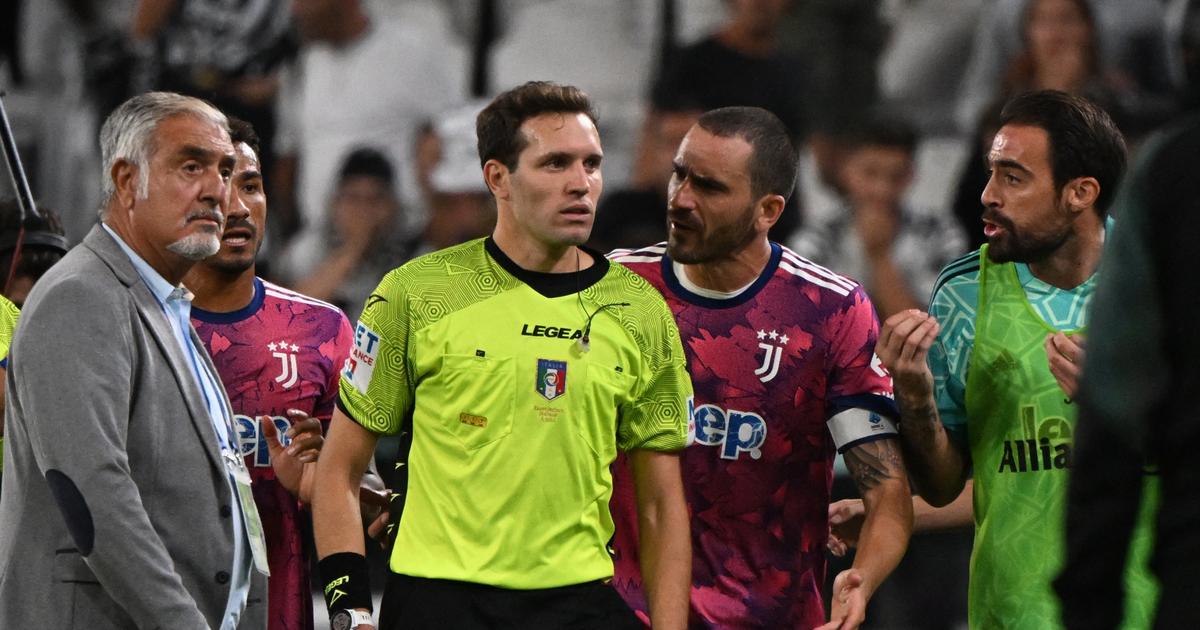While Arkadiusz Milik thought he had given Juventus the winning goal against Salernitana (2-2) on Sunday evening, referee Matteo Marcenaro finally invalidated Turin's third goal for an offside position by Leonardo Bonucci which made game action on the corner.
But an image posted after the game shows Candreva covering the line at the corner post.
To discover
Serie A standings
Serie A fixtures and results
New scandal in Italy therefore, while Juventus is the club which, according to the counts of the
Repubblica
, has experienced the most reversed decisions (44) and which has the worst ratio between favorable and unfavorable interventions (-21) since the installation of the VAR in Italy during the 2017-2018 season.
Read alsoSerie A: Juventus hooked by Salernitana in confusion
A regulated classification of matches
The placement of the cameras is decided beforehand to improve - not the refereeing decisions - but the television broadcasting of football matches.
Every three years, alongside the sale of television rights, the Lega Serie A draws up an
“audiovisual production regulation”
in which it defines the exact number of cameras needed to cover the matches.
The latest regulations, signed on August 6, 2021 for the 2021-2024 period, stipulate that the ten matches of each day of the championship will be divided into three different categories:
Type A: 18 cameras available
Type B: 16 cameras available
Type C: 12 cameras available
Infographic of TV devices in Serie A. La Gazzetta dello Sport
The choices of categorization are always made by the Italian League, in particular by its media operations office, according to the so-called production standards of the match.
The Lega recalls that the objective is to guarantee fans the best possible broadcast, all the major posters of the championship are automatically switched to type A, while the others are divided between B and C. The production costs are obviously different depending on the category of the meeting.
Type A: 52,000 - 53,000 euros
Type B: 42,000 - 43,000 euros
Type C: 32,000 - 33,000 euros
The “tactical camera” at the heart of the debates
For all categories of matches, the Italian Lega imposes two GLT (
Goal Line Technology
) cameras and a "tactical camera" in all Serie A stadiums, regardless of the category of the match.
The latter is
"placed on the main stand in a position that allows a full view of the pitch, in order to allow the understanding and analysis of the teams' game movements"
, reads the audiovisual production regulations in force this season. in Serie A.
It is the camera which, in short, allows the publication of detailed statistics such as the number of kilometers traveled by the 22 actors or the number of passes made by a team.
The meeting between Juventus and Salernitana, which reignited a controversy over VAR in Italy, was categorized by Lega type C therefore with the minimum number of cameras.
The tactical camera has such a low resolution that the images are not available on television or even accessible in the VAR room.
Referee Luca Banti, who was officiating in the VAR box on Sunday evening, therefore did not have access to the image where we can see Antonio Candreva covering Leonardo Bonucci on the corner.
Even before the Turin-Salerno episode, discussions were already advanced between the Lega and the Italian Association of Football Referees (AIA) to allow referees to benefit from the images of this “tactical camera”.
This new controversy should therefore encourage its total establishment.
Milik's header which was canceled by VAR.
www.imagephotoagency.it / PANORAMIC
In other leagues
In the Premier League, the VAR center can use all television production cameras, which operate at 50 frames per second.
To determine an offside, a “Hawk-eye” technology is used, a hawk-eye composed of both virtual lines applicable to the pitch, mapped in 3D before the start of the season, and five specific cameras calibrated and used to ensure that the VAR always has a clear view of the defender and the attacker.
In the Bundesliga, the images are analyzed with the technology of a specialized company, Sportec Solutions.
Referees still have between 19 and 21 cameras at their disposal and from this year seven more can be added to the
goal line technology
.
In La Liga, all the images from the cameras present in the stadiums are made available to the referees in the VAR truck.
The video judges are assisted by a director, who selects the images for them.
A camera commonly referred to as a '16:50' covers the entire area to the baseline and to the sides.
In Ligue 1, there are at least 12 cameras for a match, two of which are for goal-line technology.
But for some matches, the number of cameras can increase to 20. All images are available in the VAR center according to the LFP protocol, which works closely with Canal+ to add TV images.

